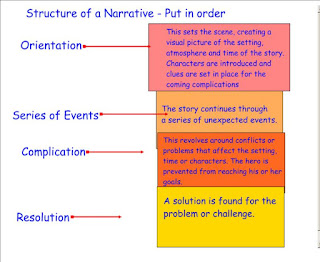Learning Reflection in a Discourse Approach in Reading
Today, I come to from conclusion that I learned A Discourse Approach in Reading this term, first of all I want to say a sense of my own before. I feel that this course has provided me with the skills to read more and to speak English is more accurate because the teacher teaches and the Cambridge Dictionary online definition of those terms.
Recount
To tell what happend.
In a recount we reconstruct past experience. A recount is the unfolding of a sequence of events over time. We are using language to keep the past alive and help us to interpret experience.It had three types were personal, factual, and Imaginative recount.
Narrative
The basic purpose of narratives is to entertain, i.e. to gain and hold the reader's interest in a story. But Narratives may also seek to teach or inform, to embody the writer's reflections on experience, and - perhaps most important - to nourish and extend the reader's imagination.There are many types of Narratives. They are typically imaginary but can be factual.
Descriptive
Its purpose is to describe and reveal a particular person, place, or thing. This kind of text helps us visualize and understand a topic. It also explains the characteristics of the subject or topic and uses details. In addition, descriptive adjectives help us visualize the topic.
Procedure
The purpose is to tell the reader how to do or make something. The information is presented in a logical sequence of events which is broken up into small sequenced steps. These texts are usually written in the present tense. The most common example of a procedural text is a recipe.
Comparison and Contrast
It presents similarities(comparisons) and differences(contrasts) between two or more things,or both similarities and differences.
Cause and Effect
Cause/Effect is used to show how the facts or concepts result due to other facts, events or concepts. Words that signal this type of text structure are Because, since, therefore, if...then, as a result of, thus, and hence. A graphic organizer may be used to represent the relationship between the causes and effects.
Definition and Classification
In textbooks, you are sure to meet unfamiliar technical words and their definitions. You will also find that writers use classification to divide general concepts into a number of different types. Identifying and understanding texts that contain definition will help me academic reading.
Exemplification
Exemplification writing uses specific, vivid examples for the purpose of adding more information to explain, persuade, define, or illustrate a general idea.
Problem and Solution
Problem and Solution is a pattern of organization where information in a passage is expressed as a dilemma or concerning issue (a problem) and something that was, can be, or should be done to remedy this issue (solution or and attempted solution).
What did you find easy?
-Personally, I think the easiest way is to find words even if the context does not match exactly, but they can easily define.
-Personally, I think the easiest way is to find words even if the context does not match exactly, but they can easily define.
What did you find difficult?
-Personally, I think all the chapters are similar to the discourse markers is difficult enough to learn before they take action every time.
What did you solve the problem?
-I used to read them to understand the material, trying to find answers and underlined every time I answer to stress that we do it right. I used scanning and skimming the time to read and use the Cambridge Dictionary Online all the time meant to read that correctly.
What are your attitudes towards the Discourse Approach in Reading?
-Personally, I think this course is very necessary in the life of a teacher to me. Because we are of course important, it will give us the knowledge to be taught to children is the future of the nation with equivalent efficacy.















